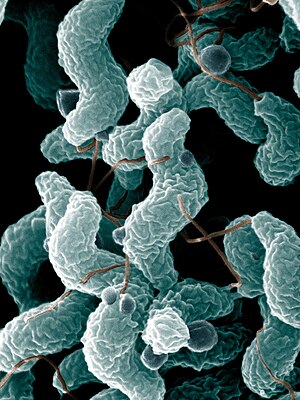Campylobacter jejuni
| Campylobacter jejuni | ||||||||||||
|---|---|---|---|---|---|---|---|---|---|---|---|---|

Campylobacter jejuni |
||||||||||||
| Systematics | ||||||||||||
|
||||||||||||
| Scientific name | ||||||||||||
| Campylobacter jejuni | ||||||||||||
| ( Jones et al. 1931) Véron & Chatelain 1973 |


Campylobacter jejuni is a microaerophilic , gram-negative bacterium of the genus Campylobacter , which in humans can cause diarrhea ( Campylobacter enteritis ) inparticular. The genome of this species was completely sequenced in 2005.
description
Morphologically , Campylobacter jejuni are slender, spirally curved rods that are 0.2–0.5 µm thick and 0.5 to 5 µm long. There is a single scourge at both poles .
The pathogens are transmitted from animals to humans through food and drinking water. Direct smear infection also occurs, especially in children. The infection often occurs in summer and autumn.
The incubation period after infection is 2 to 5 days. The optimal growth temperature for cultivation is 42–45 ° C. When stored at 25 ° C, the germs die, but paradoxically they survive refrigerator temperatures for weeks. As a rule, 55 ° C is sufficient to kill these germs in food . Therefore, thorough cooking of meat, especially poultry meat, and decoction of raw milk are important preventive measures .
Medical importance
Possible sources of infection
The following are known as possible sources of infection:
- raw cow's milk (untreated)
- contaminated, non-chlorinated drinking water (especially in southern countries)
- contaminated animal food (especially meat , e.g. not fully cooked poultry meat , but also pork , as well as raw clams and other shellfish )
- Contact with animals (especially cats, dogs, birds, cattle and poultry)
- Smear infection from person to person
It should be noted that around 500 germs are sufficient for an infection.
Pathogenicity
Nothing more is known about the mechanisms of the pathogenicity of these pathogens. However, Campylobacter jejuni forms a heat-stable enterotoxin that is similar to that of Escherichia coli .
Course of infection
After an incubation period of two to 5 days (in individual cases 1–10 days), the following symptoms may become noticeable:
- severe colicky abdominal pain
- frequent watery diarrhea (diarrhea) e.g. Sometimes with mucus and blood deposits
- high fever
- occasional vomiting
Often, before the onset of diarrhea symptoms, a one to two-day preliminary stage occurs, which is characterized by high fever, a strong feeling of illness, muscle pain and headache. The pathogen is excreted in the stool, the elimination time after the disease is usually three to four weeks. Infection is possible during this period.
Possible infectious diseases and their consequences
Campylobacter jejuni travels through the intestinal epithelia and spreads subepithelially.
- Enterocolitis with watery diarrhea
- Campylobacter enteritis
- fever
- arthritis
- Cholecystitis
- Salpingitis
- sepsis
- meningitis
- Peritonitis
- Erythema nodosum
The Guillain-Barré syndrome occurs more frequently after infections with Campylobacter jejuni . Molecular mimicry is discussed as the reason for this .
therapy
Antibiotic therapy is only carried out in individual cases with erythromycin ; as a rule, spontaneous healing occurs with symptomatic therapy, i.e. H. Fluid and electrolyte replacement. In Germany, Switzerland and Austria there is an obligation to notify, in Germany the Infection Protection Act (IfSG) applies . According to § 7 IfSG, the detection of enteric pathogenic Campylobacter species is notifiable in the event of an infection; according to § 6 IfSG, suspicion and illness are already notifiable if the person concerned works in certain food establishments (§ 42 IfSG).
diagnosis
A culture isolated from stool is used for detection. Campylobacter jejuni can be cultivated on blood agar plates under a microaerophilic atmosphere with 10% CO 2 and 5% O 2 . Selected antibiotics are added to the nutrient medium in order to suppress the growth of accompanying flora (e.g. Enterobacteriaceae ) in the stool. The optimal growth temperature for C. jejuni is 42 ° C, while the related species Campylobacter fetus grows better at 25 ° C.
The presence of C. jejuni and related species Campylobacter coli can also faster right in the chair by means of the ELISA -Verfahrens (detection of antigens ) or using the PCR -Verfahrens (detection of nucleic acids ) are conducted.
Reporting requirement
In Germany, direct or indirect detection of enteric pathogenic Campylobacter sp. Specifically notifiable in accordance with Section 7 of the Infection Protection Act (IfSG), provided that the evidence indicates an acute infection. The obligation to notify primarily concerns the management of laboratories ( § 8 IfSG).
In Switzerland, the positive and negative laboratory results of Campylobacter spp. Laboratory notifiable namely according to the Epidemics Act (EpG) in connection with the epidemic Regulation and Annex 3 of the Regulation of EDI on the reporting of observations of communicable diseases of man .
Individual evidence
- ↑ a b c Michael T. Madigan, John M. Martinko, Jack Parker: Brock Mikrobiologie. German translation edited by Werner Goebel, 1st edition. Spektrum Akademischer Verlag GmbH, Heidelberg / Berlin 2000, ISBN 978-3-8274-0566-1 .
- ↑ Campylobacter jejuni RM1221 on the Genomes Online Database (GOLD) website. Retrieved February 24, 2013 .
- ↑ a b c d e Herbert Hof, Rüdiger Dörries: Dual series: Medical microbiology. 3. Edition. Thieme Verlag, Stuttgart 2005, ISBN 978-3-13-125313-2 .
- ↑ a b c d e f g Campylobacter infections - RKI guide for doctors . Robert Koch Institute (RKI), accessed on February 24, 2013 .
- ↑ Jeremy H. Rees, Sara E. Soudain, Norman A. Gregson, Richard AC Hughes: Campylobacter jejuni Infection and Guillain-Barré Syndrome . In: New England Journal of Medicine . tape 333 , no. 21 , 23 November 1995, ISSN 0028-4793 , p. 1374-1379 , doi : 10.1056 / nejm199511233332102 , PMID 7477117 .
